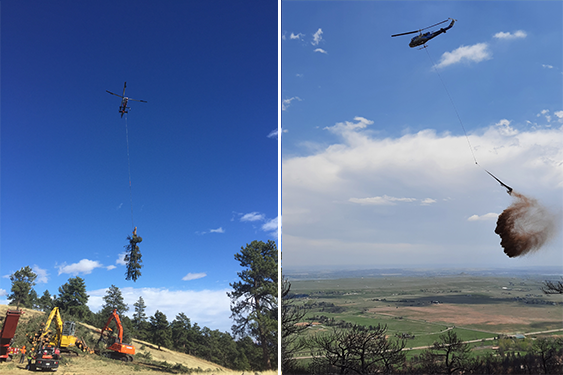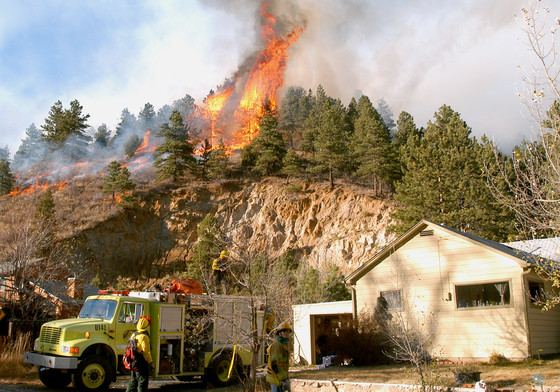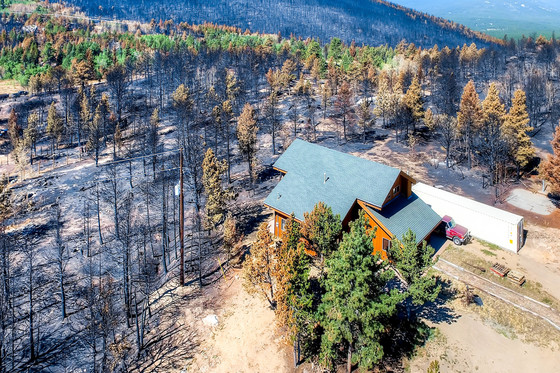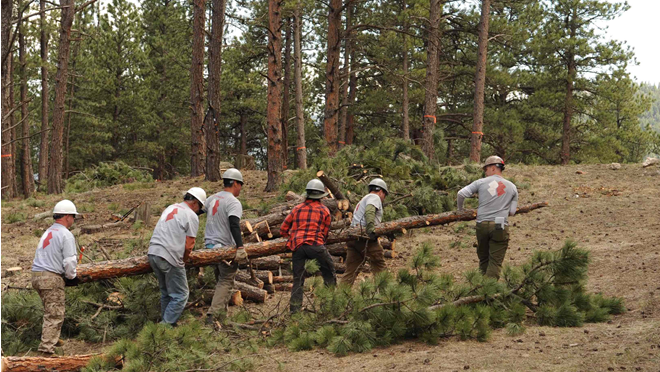May 27, 2021
Boulder County, partners, and communities ramp up forestry projects to create more climate and wildfire resilient forests
Charting a course to making forests more resilient to climate change and wildfire destruction

Fireshed forestry mitigation efforts such as (l. to r.) strategic aerial tree removal projects (Betasso Open Space, 2016) and aerial mulching to repair scorched wildland fire burn areas (Heil Ranch Open Space, 2021) are all part of creating a more resilient and climate adaptive forest system and wildland-urban interface.
(May 27, 2021) -- In the wake of the most intense wildfire season in Colorado history, Boulder County is increasing its investment and work with partners and communities to prepare for a future with increasingly frequent and intense wildfire occurrences.
Scientists anticipate a more regular occurrence of wildfire seasons like the one Colorado experienced in 2020, which involved large, long-duration wildfires occurring at higher elevations and in different vegetation types than previously seen.
The Calwood Fire (October 2020) burned over 10,000 acres in Boulder County, the largest in county history, while the Cameron Peak fire, a mere 15 miles north of the Boulder County line, burned over 200,000 acres; the largest in Colorado history. (Note: All the forested lands in Boulder County amount to 207,731 acres.)
Threats to homes and communities, drinking water supplies, recreation opportunities, air quality and wildlife in the county are much greater with longer and more intense wildfire seasons.
Eliminating fires from the landscape is neither possible nor healthy for the forest so we need to prepare our communities, water sources and natural spaces to be resilient when wildfire does happen. We saw the impact of strategically placed forest thinning and prescribed fire in slowing down the Cameron Peak fire and stopping it in places. Without those proactive measures, the fire could have run through housing developments and burned forests around Elkhorn Creek, a vital water source for downstream cities and farms. –Tony Cheng, Director of the Colorado Forest Restoration Institute at Colorado State University

Firefighters stand ready to defend a home from the Overland Fire (2003) near Jamestown, Colo. Under increasingly intense wildfire conditions, firefighting response supports like these are stretched thin.
Establishing the Boulder County Fireshed
Since signing an agreement last summer to align their efforts, a coalition of federal, state, county and municipal agencies, has been working even more closely with non-profit entities in Boulder County to meet with communities and prioritize areas for treatments especially where those areas include multiple ownerships such that they cross private, county and federal lands.
The county and its partners in the Boulder County Fireshed are engaging with communities and stakeholders both in the forest and downstream to set goals and priorities so that our county forests will be healthier and better able to withstand the effects of wildfire.
The Calwood Fire is a call for more action. Something like the Cameron Peak fire – twenty times the size of the Calwood fire – occurring in Boulder County would be devastating to our residents, our economy and all that we cherish about this place. We are planning for and acting on that threat now given the science and what we experienced last summer. – Boulder County Commissioner Matt Jones.
We are fortunate in Boulder County to have strong partnerships with so many agencies and nonprofit organizations, which allows us to plan our work collaboratively, across boundaries. One of our most important partnerships, however, is with the public and visitors who recreate and live here. Good stewardship of the land begins with every person who spends time on the National Forest. Whether its implementing defensible space around your own property or making certain your campfire is not going to start a wildfire, we can all play a part in this collective effort. – Angela Gee, District Ranger with the Roosevelt National Forest.

Example of a house spared from destruction by the Cold Springs Fire (2016) near Nederland, Colo., due to the establishment of defensible space around the perimeter of the home.
Partners of the Boulder County Fireshed have numerous forest health and community protection efforts underway
Below is a partial list with views from leadership of some of those efforts:
St. Vrain Forest Health Partnership
The St. Vrain Forest Health Partnership is bringing together diverse partners and community members to collaboratively plan and implement landscape-scale forest restoration in the 625,000 acre St. Vrain Watershed that will prepare the land and the community to receive wildland fire as a natural part of the ecosystem. In the heart of this watershed,
Button Rock Preserve is the primary water source for 100,000 domestic water users in the county and provides regional recreation to over 60,000 visitors annually. The watershed includes Allenspark, Lyons, and the City of Longmont and they are all participating in the Partnership.
We have had over 30 stakeholder representatives come together to build a common vision for the future of the forested landscape in the St. Vrain. This is an incredible opportunity to build consensus and a plan for landscape scale forest restoration in advance of the USDA Forest Service’s formal NEPA process for the federal land portion of the St. Vrain Watershed. The partnership’s next phase includes building agreement on priority areas for treatments, planning for their restoration and how we will monitor and adjust our plans once the work on the ground gets underway. – Jessie Olson, Executive Director of the Left Hand Watershed Center, who is leading the St. Vrain effort
Boulder Watershed Collective
The Boulder Watershed Collective is working with communities, fire districts, and agency partners within the Boulder Creek Watershed to increase our collective knowledge about forest ecology and wildfire adapted ecosystems, build capacity within communities to plan and implement more forestry projects across land ownership and identify gaps to reduce wildfire risk at the community and landscape scale.
The town of Gold Hill, the Gold Hill Fire District, Boulder Valley Conservation District, and the Colorado State Forest Service are working together to begin a 100-acre forest restoration project this summer. The town has used this project to galvanize momentum for future project planning and are taking a community-oriented approach to completing home hardening and defensible space on private properties.
We are excited to watch the multi-objective projects developing in Gold Hill and use this as a model for how other communities can collaborate to reduce their wildfire risk, protect their neighborhoods and improve the health of surrounding forests. – Maya MacHamer, Director, Boulder Watershed Collective
Lefthand Fire Protection District
Lefthand Fire Protection District is working with Boulder County, the county’s Wildfire Partners program, and private property owners following the Calwood Fire given the increased interest of residents in lessening the fire risk to their homes and property.
Our mitigation crews are working hard to remove the fire killed trees over eight inches in diameter on private properties for the aerial mulching project over the burn scar, as well as working with property owners who have taken advantage of the Wildfire Partners program to learn what is necessary to protect their homes and have recommended work around them. The work of wildfire mitigation around homes is easy to stay in front of with regular maintenance once the primary mitigation plan is met. We plan to perform mitigation work on 62 homes in the area this summer which is many more than previous summers and that is a huge help for the communities, the forest and the watershed in terms of wildfire protection. – Chris O’Brien, Lefthand Fire Chief
Boulder Valley & Longmont Conservation Districts
The Boulder Valley & Longmont Conservation Districts have entered into a partnership with the American Forest Foundation to add professional foresters to assist with critical landscapes of Boulder County. With a generous contribution from the St. Vrain & Left Hand Water Conservancy District, the conservation districts have hired two foresters to provide technical assistance in the form of Natural Resource Conservation Service planning and ultimately completing free forest management plans for private landowners in 2021.
This program allows conservation district staff to complete Forest Management Plans at no cost to private landowners and to prepare them to work with the NRCS to apply for cost-share assistance to implement forest management activities and improve soil and water conservation issues on their land. – Vanessa McCracken, Boulder Valley & Longmont Conservation District Manager
For more information about Forest Management Plans, contact the Boulder Valley & Longmont Conservation Districts at 720-378-5521.
City of Boulder
The City of Boulder is continuing its long-standing dedication to forest health and fire mitigation projects on city managed lands. It is implementing projects at multiple scales to address the risks of wildfire to the community. After the 2020 fire season, the City of Boulder Open Space and Mountain Parks department has dedicated additional budget in 2021 to increase staffing and expand thinning efforts to address wildfire risk in the city’s wildland-urban interface.
The city has plans to thin over 200 acres in the Shanahan Ridge, Chautauqua, and Sunshine Canyon areas during 2021. This is in addition to the over 2000 acres of thinning completed in past years. Within city limits, the Boulder Fire Department’s Wildland Division has a Wildfire Home Assessment Program that can help property owners identify risks and mitigate threats on their private property. And broader scale, the City Utilities Department is working on larger collaborative forest health projects to address fire risk in the Middle Boulder Creek Watershed to protect drinking water supplies for Boulder and Nederland.
All of these efforts are working towards making the City of Boulder more resilient in the face of increasingly extreme wildfire seasons.
Boulder is committed to doing what we can to address the threat of wildfire to the city. We’re excited to continue to be a partner on county-wide forest management efforts and support the great work that is happening across the landscape and right in our backyard.
– Chris Wanner, Vegetation Stewardship Supervisor, City of Boulder Open Space and Mountain Parks
City of Longmont
The City of Longmont is currently performing a 40 acre forest stewardship thinning project in Button Rock Preserve just west of Ralph Price Reservoir. Ralph Price Reservoir is the primary source of drinking water for the communities of Lyons and Longmont. This forestry project is a continuation of a multi-decade effort to improve forest health in the Button Rock area, protect the North St. Vrain watershed, and reduce risk of catastrophic wildfire. Wood harvested during this project will be utilized in aerial mulching in the CalWood Fire burn area in coordination with Boulder County and other agency partners.
For more information on forest stewardship efforts at Button Rock Preserve, please visit the City webpage.
Colorado State Forest Service
On May 10, the CSFS officially launched The Home Ignition Zone, (HIZ) a guide to prepare your home for wildfire and create defensible space. The HIZ takes into account both the potential of the home or structure to ignite and the quality of nearby defensible space.
The Boulder Field Office of the CSFS is working to ensure governmental and private forestry grant dollars are making a difference in conjunction with local agencies and landowners in priority watersheds of Boulder and Gilpin Counties. We also assist private landowners manage their forests to improve forest health and reduce wildfire risk.
In particular, the CSFS is developing forest management plans with landowners in the St. Vrain and Coal Creek Watersheds in a project funded by the US Department of Agriculture through the American Forest Foundation. As well, CSFS is pleased to be partnering with the Boulder Watershed Collective, Gold Hill residents, and others to help reduce wildfire risk to that community.
Roosevelt National Forest, Boulder Ranger District
The Forest is participating in the collaborative efforts of the St. Vrain Forest Health Partnership and the Boulder Watershed Collective, from attending public outreach events across the county this summer to coordinating areas where adjacent private and public lands might both benefit from some forest health improvements. As part of this effort, the Forest in partnership with Boulder County Wildfire Partners, recently outreached to residents who are interested in creating defensible space around their homes and is now processing 13 applications from neighbors that will allow them to remove trees along their National Forest boundaries.
In addition to 400 acres of prescribed pile burning across the district over the past winter and spring, the Forest will complete thinning projects across nearly 600 acres associated with the Forsythe II Project this summer. This work will reduce the density of trees in thickly forested stands while also enhancing aspen. These types of projects are important in helping the remaining trees thrive, while returning the forest to a more fire-resilient condition. Finally, the Forest is actively engaging with partners to plan and implement fire recovery efforts on both the Calwood and Lefthand Fires.
Boulder County
Calwood Fire recovery efforts are fully underway with funding from the Emergency Watershed Protection program from the Natural Resources Conservation Service. Aerial wood mulching on ~1700 acres is being completed in order to decrease the chances of erosion and debris flows, while flooding/debris mitigation structures will be built to minimize damages from increased run off.
The County through its Parks and Open Space (BCPOS) department is gearing up to complete a 100-acre thinning project on the Sherwood Gulch property west of Nederland. BCPOS is also applying for grant funding to complete 76 acres of treatment at Hall Ranch adjacent to a 40-acre project planned by the City of Longmont. BCPOS in cooperation with the Boulder County Sheriff’s Office is planning on completing prescribed fire on up to 350 acres at Ron Stewart Preserve at Rabbit Mountain and has 800+ acres earmarked for prescribed fire at Hall Ranch over the next few years.
Areas where we had completed past treatments seemed to fair better during the Calwood Fire. This is a strong incentive to complete these landscape scale treatments and work with our land management partners and landowners to complete fuels reduction and restoration treatments across property lines. – Stefan Reinold, Senior Forester, Boulder County Parks & Open Space
In addition to the work being conducted by the county, many homeowners in the foothills and mountains are also preparing for future wildfires by joining Wildfire Partners. Since 2014, Wildfire Partners has helped more than 2,500 homeowners make their homes safer.
To learn more, visit https://www.WildfirePartners.org.


